New Invention Can Turn Seawater Into Hydrogen Fuel

Equatic pushes scientists new approach to producing hydrogen fuel. The scientists have discovered a way to use seawater to make hydrogen fuel. The machine will run for up to three years without the need for the anode, a key part of the process, to be serviced.
Scientists have found a way to use electrodes to split seawater and turn it into hydrogen fuel. Normally this would create a corrosive and toxic chlorine gas by-product. However, with this new method, researchers are able to generate clean fuel using electrolysis, while also removing the need to have pure water to do so cleanly.
This new process is being pushed by a California-based start-up, Equatic, with support from ARPA-E, and the group plans to sell the hydrogen created by its invention to help offset the cost of the process. But how exactly does Equatic go about making hydrogen fuel without creating those corrosive byproducts?
To understand, we need to look at how these systems typically work
Normally, water is turned into hydrogen fuel using an electrolyzer—a machine that relies on stacks of electrodes to separate the water molecules using electricity. However, existing electrolyzers have problems turning seawater into hydrogen fuel because of the corrosive minerals and dissolved salt that are separated from the water.
These often cause the machines to stop working, with the internal pieces becoming gummed up or rusted. Because the electrical charge used to separate the salt in the seawater attracts oxygen, it also creates toxic chlorine gas, which corrodes the machine.
To solve this problem, though, Equatic’s co-founder Xin Chen and his colleagues designed an anode that can selectively split the water molecules from the oxygen without splitting the salt, too.
It then pushes the water through a chlorine-blocking layer that stops the salt. This allows the machine to turn seawater into hydrogen fuel without gumming everything up.
What’s even more impressive about this new machine is that the researchers believe it should work for at least three years before the anode needs to be removed and recoated. This is, of course, just the latest development we’ve seen involving saltwater. Researchers have also been looking for ways to turn saltwater into drinking water more efficiently.
That’s because the ocean is the most abundant source of water on our planet. As such, finding ways to harness that water has become a goal for researchers in various fields.

